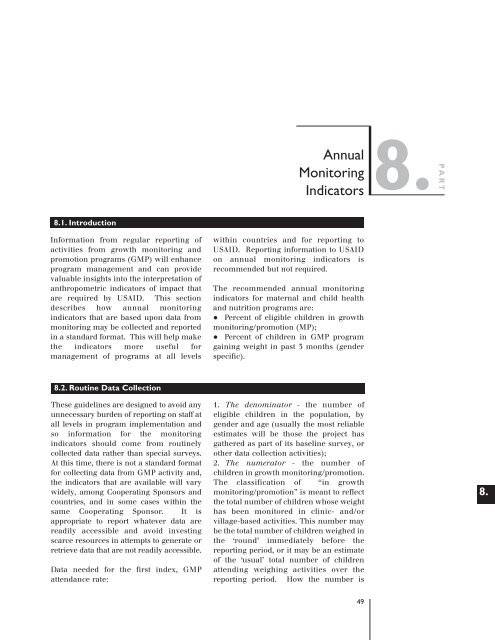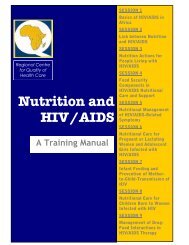2.1: Anthropometric Indicators Measurement Guide - Linkages Project
2.1: Anthropometric Indicators Measurement Guide - Linkages Project
2.1: Anthropometric Indicators Measurement Guide - Linkages Project
Create successful ePaper yourself
Turn your PDF publications into a flip-book with our unique Google optimized e-Paper software.
Annual<br />
Monitoring<br />
<strong>Indicators</strong><br />
8.<br />
P ART<br />
8.1. Introduction<br />
Information from regular reporting of<br />
activities from growth monitoring and<br />
promotion programs (GMP) will enhance<br />
program management and can provide<br />
valuable insights into the interpretation of<br />
anthropometric indicators of impact that<br />
are required by USAID. This section<br />
describes how annual monitoring<br />
indicators that are based upon data from<br />
monitoring may be collected and reported<br />
in a standard format. This will help make<br />
the indicators more useful for<br />
management of programs at all levels<br />
within countries and for reporting to<br />
USAID. Reporting information to USAID<br />
on annual monitoring indicators is<br />
recommended but not required.<br />
The recommended annual monitoring<br />
indicators for maternal and child health<br />
and nutrition programs are:<br />
• Percent of eligible children in growth<br />
monitoring/promotion (MP);<br />
• Percent of children in GMP program<br />
gaining weight in past 3 months (gender<br />
specific).<br />
8.2. Routine Data Collection<br />
These guidelines are designed to avoid any<br />
unnecessary burden of reporting on staff at<br />
all levels in program implementation and<br />
so information for the monitoring<br />
indicators should come from routinely<br />
collected data rather than special surveys.<br />
At this time, there is not a standard format<br />
for collecting data from GMP activity and,<br />
the indicators that are available will vary<br />
widely, among Cooperating Sponsors and<br />
countries, and in some cases within the<br />
same Cooperating Sponsor. It is<br />
appropriate to report whatever data are<br />
readily accessible and avoid investing<br />
scarce resources in attempts to generate or<br />
retrieve data that are not readily accessible.<br />
Data needed for the first index, GMP<br />
attendance rate:<br />
1. The denominator - the number of<br />
eligible children in the population, by<br />
gender and age (usually the most reliable<br />
estimates will be those the project has<br />
gathered as part of its baseline survey, or<br />
other data collection activities);<br />
2. The numerator - the number of<br />
children in growth monitoring/promotion.<br />
The classification of “in growth<br />
monitoring/promotion” is meant to reflect<br />
the total number of children whose weight<br />
has been monitored in clinic- and/or<br />
village-based activities. This number may<br />
be the total number of children weighed in<br />
the ‘round’ immediately before the<br />
reporting period, or it may be an estimate<br />
of the ‘usual’ total number of children<br />
attending weighing activities over the<br />
reporting period. How the number is<br />
8.<br />
49

















